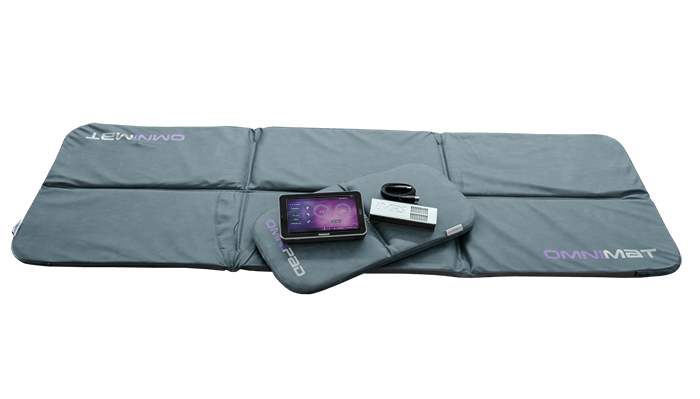OMNIUM PEMF
Enhance osteogenic loading recovery with the power of
pulsating electromagnetic field therapy
When NASA noticed its astronauts returning from space feeling ill and exhausted, it began to research the effects of magnetic fields on human performance.
When the agency added pulsating electromagnetic fields to its spacecraft, the problem disappeared. NASA’s four-year study proved that PEMF—pulsed electromagnetic field—therapy can improve the growth and repair of tissues in humans and animals. (1) Since then, this therapy has been widely used in both medical and at-home settings to enhance healing and relieve pain. You can think of a PEMF therapy session as jumpstarting your cells back to health.
The OMNI PEMF mat is designed to deliver the benefits of PEMF therapy in non-medical settings such as our OsteoStrong Centers. This light, portable mat comes with three programmed settings and can be manually adjusted to deliver the optimal frequency for each member. This modality is ideal following a Spectrum session. PEMF helps our members recover from osteogenic loading and helps them walk out the door feeling their best.
BONE DENSITY BENEFITS
• Slows the loss of bone mass: Curbs bone mass loss, (2) including bone loss induced by estrogen deficit and disuse, and in individuals with Type 2 Diabetes. (3)
• Facilitates new bone growth: Has a proven positive effect on the regeneration of musculoskeletal tissues such as cartilage, bone, tendon and ligament (4 ); clinically approved by worldwide regulatory bodies for the adjunctive treatment of recalcitrant fractures and other bone fracture repair applications 5 ; has been shown to increase bone mineral density in osteoporosis-prone women. (6)
• Beneficial for a variety of bone disorders: Used to promote healing and osteogenesis in conditions including fresh fracture, delayed and nonunion fractures, diabetic osteopenia, osteoporosis, osteonecrosis and osteoarthritis. (7)
HEALTH AND WELLNESS BENEFITS
• Improves circulation: Increases capillary velocity and diameter in chronic wounds, promoting improved microcirculation. (8)
• Accelerates healing: An effective adjunctive therapy for the treatment of both delayed-union fractures and chronic wounds, with proven abilities to accelerate wound closure (9) and deliver benefits at various stages of healing. (10)
• Enhances immune system health: Modulates the immune system’s response in the presence of infections, (11) which can also decrease inflammation and enhance the healing process. (12)
• Reduces pain and inflammation: Widely used as a treatment for postoperative pain and edema in both outpatient and home settings (13); relieves pain and edema in patients with chronic back pain 14 and following injury or surgery (15); decreases chronic inflammation by mediating the expression of genes important to inhibiting and resolving this biological response. (16)
• Enhances muscle recovery: Triggers myosin phosphorylation, which helps shorten recovery time through the production of ATP; reduces delayed onset muscle soreness (DOMS) in athletes such as marathon runners. (17)
• Improves mood: Enhances mood for some patients with depression (18); improves quality of life and reduces anxiety for people experiencing pain.
CONTRAINDICATIONS
Consult your doctor if you are considering using complementary therapies alongside conventional medical treatment. PEMF treatments are contraindicated in people with the following conditions:
• Pacemakers or other electronic implants
• Cochlear implants or mechanical heart valves
• Pregnancy
• Epilepsy or bleeding
• Organ transplant recipients
• Individuals receiving immunosuppressive therapy
• Individuals with non-MRI safe IUDs.
For more information on the risk associated with this modality, please visit the Oxford Medicals website (omnium1.net).
CITATIONS
1 https://ntrs.nasa.gov/archive/nasa/casi.ntrs.nasa.gov/20030075722.pdf
2 https://www.ncbi.nlm.nih.gov/pmc/articles/PMC4749801/; https://www.ncbi.nlm.nih.gov/pubmed/2527331
3 https://www.nature.com/articles/s41598-017-11090-7
4 https://www.ncbi.nlm.nih.gov/pmc/articles/PMC2714496/;
https://www.ncbi.nlm.nih.gov/pubmed/28026095/
5 https://www.ncbi.nlm.nih.gov/pubmed/29356996
6 https://www.ncbi.nlm.nih.gov/pubmed/2195843
7 https://www.ncbi.nlm.nih.gov/pmc/articles/PMC4749801/
8 https://www.ncbi.nlm.nih.gov/pubmed/25882659
9 https://www.ncbi.nlm.nih.gov/pubmed/1894496
10 https://www.ncbi.nlm.nih.gov/pmc/articles/PMC5764361/
11 https://www.ncbi.nlm.nih.gov/pubmed/30203577
12 https://www.ncbi.nlm.nih.gov/pubmed/27475897
13 https://www.ncbi.nlm.nih.gov/pubmed/22301609/
14 https://www.future-science.com/doi/10.4155/fsoa-2015-0019
15 https://www.ncbi.nlm.nih.gov/pubmed/22037572
16 https://www.ncbi.nlm.nih.gov/pmc/articles/PMC4346366/
17 https://online.boneandjoint.org.uk/doi/abs/10.1302/1358-992X.94BSUPP_XXXVII.EFORT2011-491
18 https://ajp.psychiatryonline.org/doi/full/10.1176/ajp.154.12.1752
19 https://www.ncbi.nlm.nih.gov/pubmed/31385489

